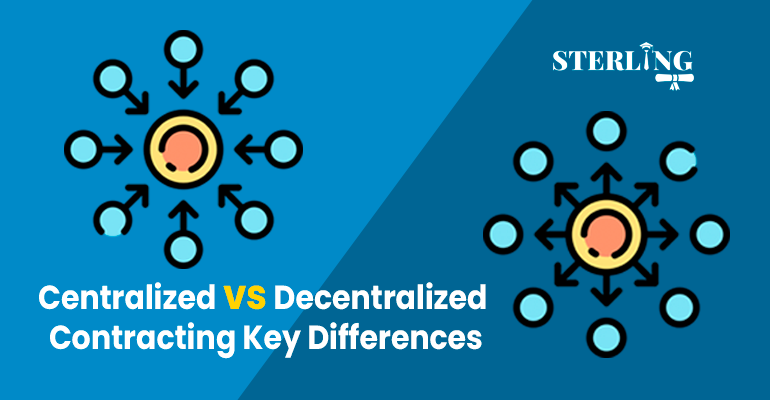- Call us now for any inquiry +1 832-957-9587
- Mail us for any query : support@sterlingnext.com
Centralized vs Decentralized Contracting Key Differences
Training Outcomes Within Your Budget!
We ensure quality, budget-alignment, and timely delivery by our expert instructors.
Table of Content
- Compare Centralized and Decentralized Contracting Models
- What Is Centralized Contracting?
- Key Characteristics:
- What Is Decentralized Contracting?
- Key Characteristics:
- Centralized vs Decentralized Contracting: Key Differences
- When to Use Centralized Procurement
- When to Use Decentralized Procurement
- Advantages of Centralized Contracting
- Advantages of Decentralized Contracting
- Hybrid Contracting Approach
- Contract Management in Projects
- How These Models Affect Project Management and Procurement
- Project Planning Impact
- Budget Tracking
- Choosing the Right Model
- Best Practices for All Models
- Tools That Help
- Common Tools:
- New Trends in Contracting
- Trends to Watch:
- Importance of Training in Contracting Models
- How Sterlingnext Supports Project Management and Procurement Learning
Recent Blogs
Build Stunning HTML and CSS Projects for Your Portfolio
September 11th, 2025
CISA Certification Requirements and Career Path The Complete Guide
September 11th, 2025
Project Manager Job Description with Key Skills Explained
September 11th, 2025
Top Ways to Reward and Motivate Project Team Recognition
September 11th, 2025
Six Sigma Certification Path to Professional Success
September 11th, 2025
Clear and Concise Approach to Mastering PRINCE2 Foundation
September 11th, 2025
Project Estimation Accuracy: Key Tips for Better Results
September 11th, 2025
Most Asked Project Management Interview Questions Guide
September 11th, 2025
AWS Solution Architect Role Guide with Career Clarity
September 11th, 2025
Final Year Computer Science Project Ideas for Every Skill
September 11th, 2025

Understanding the difference between Centralized vs Decentralized Contracting is important for any organization managing contracts and vendors. These two approaches affect how teams handle agreements, interact with suppliers, and manage project procurement. Choosing the right approach can improve efficiency and reduce risks.
Get Certified With Industry Level Projects & Fast Track Your Career
Checkout Top 10 Highest Paying Jobs
Compare Centralized and Decentralized Contracting Models
Understanding the difference between Centralized vs Decentralized Contracting is important for any organization managing contracts and vendors. These two approaches affect how teams handle agreements, interact with suppliers, and manage project procurement. Choosing the right approach can improve efficiency and reduce risks.
This guide will help you understand both models, when to use each, and how they affect your overall project and procurement process. We'll also explore trends, tools, and best practices to support modern contract management.
What Is Centralized Contracting?
Centralized Contracting means one main department handles contracts across the entire organization. This team manages vendor selection, pricing, compliance, and documentation.
Key Characteristics:
- A single team manages all contracts
- Same process and documents across departments
- Better control and standardization
- Easier to manage legal and financial risks
- Streamlined vendor evaluation and selection process
Centralized procurement works well in organizations that want consistency and cost control. It fits structured environments where projects follow similar rules.
What Is Decentralized Contracting?
Decentralized Contracting allows teams, departments, or branches to manage their own contracts. These teams choose vendors, negotiate terms, and manage their own paperwork.
Key Characteristics:
- Local teams manage their contracts
- More flexibility to meet specific project needs
- Quicker decisions and faster execution
- Teams are more directly involved in contract outcomes
- Stronger alignment with team-specific objectives
Decentralized procurement is useful when teams are spread across locations or work on different types of projects.
Centralized vs Decentralized Contracting: Key Differences
Let’s compare Centralized vs Decentralized Contracting in simple terms:
|
Aspect |
Centralized Contracting |
Decentralized Contracting |
|
Control |
Managed by a central team |
Managed by individual teams |
|
Speed |
Can be slower |
Faster decisions locally |
|
Flexibility |
Low |
High |
|
Consistency |
High |
Varies |
|
Risk |
Easier to manage |
May vary by team |
|
Cost |
Can reduce costs |
Less cost control |
|
Vendor Access |
Limited to approved list |
Broader vendor pool |
|
Customization |
Standard templates |
Tailored agreements possible |
Each model has benefits depending on how your organization runs and what kind of projects you take on.
When to Use Centralized Procurement
Centralized procurement works well when:
- You need strict control over contract terms
- Your projects are similar in structure
- You want to manage large vendors across multiple projects
- Legal or compliance rules are strict
- There's a need to negotiate bulk pricing
- Vendor performance is reviewed by a centralized quality team
Central reporting and accountability are required
When to Use Decentralized Procurement
Decentralized procurement makes sense when:
- Projects have different needs
- Teams are in different regions or time zones
- Fast decisions are important
- Teams know their specific suppliers well
- Local vendors offer better service or pricing
- Project managers prefer autonomy in supplier relationships
Innovation and team ownership are emphasized
Advantages of Centralized Contracting
- Standardized Contracts: Everyone uses the same format
- Better Pricing: Combining purchases saves money
- Expert Oversight: A trained team handles all negotiations
- Risk Control: Easier to track and manage contract terms
- Legal Compliance: Central teams follow up-to-date regulations
- Vendor Performance Tracking: Easier to compare across projects
- Audit Readiness: Easier documentation and compliance reviews
Advantages of Decentralized Contracting
- Faster Response: Local teams act quickly
- Tailored Contracts: Fit project needs more closely
- Team Ownership: Teams are more involved in outcomes
- Better Local Supplier Relationships: Teams know their vendors
- Agility: Local teams adapt quickly to changing project scopes
- Cultural Alignment: Local procurement aligns better with local customs or practices
- Innovation: Teams may test unique tools or suppliers
Hybrid Contracting Approach
Some companies use a mix of both. A central team handles big or legal-heavy contracts, while smaller or local contracts are managed by project teams.
This hybrid model offers balance:
- Standardization for big deals
- Flexibility for smaller needs
- Shared tools between departments for efficiency
- Regional compliance without losing corporate governance
Collaborative workflows across centralized and decentralized teams
Contract Management in Projects
Contract Management in Projects means handling agreements from the start to the end of a project. It involves:
- Choosing vendors
- Finalizing and signing contracts
- Monitoring progress
- Managing issues or changes
- Ensuring all terms are met
- Closing contracts upon completion
No matter which model you use, good contract management is key to avoiding delays and issues.
How These Models Affect Project Management and Procurement
Your choice between Centralized vs Decentralized Contracting will affect how you plan, buy, and track project tasks. In Project Procurement Management, centralized models help reduce duplicate work but can slow things down. Decentralized models speed things up but may create gaps in compliance.
Good alignment between procurement and project managers is important in either setup. This keeps project timelines and budgets on track.
Project Planning Impact
- Centralized systems integrate with project scheduling tools
- Decentralized models may require syncing updates across departments
- Collaboration platforms reduce confusion in both setups
Budget Tracking
- Central models offer consistent budget reports
- Decentralized models may report per team, needing extra review
- Real-time dashboards can aid transparency
Choosing the Right Model
Ask yourself:
- Are all your projects similar?
- Are teams in one place or across many regions?
- Do teams have time and skills to manage contracts?
- Are legal requirements tight?
- Do you need faster procurement processes?
- What level of control do you need over vendor negotiations?
The answers help decide whether centralized, decentralized, or a mix of both works best.
Best Practices for All Models
Regardless of your choice, use these steps to manage contracts well:
- Set clear guidelines for contract handling
- Use simple, consistent templates
- Train teams on basic contract skills
- Review contracts regularly
- Use tools to track deadlines and updates
- Involve legal advisors during major contract changes
- Keep a record of vendor evaluations
Align processes with project management and procurement goals
Tools That Help
Digital tools support both models. These tools help:
- Store contract templates
- Send reminders for renewals
- Keep a log of contract changes
- Set user roles and permissions
- Share contract access across global teams
- Manage audit trails for compliance
This makes contracting smoother and more organized.
Common Tools:
- DocuSign
- Adobe Sign
- SAP Ariba
- Coupa
- ContractWorks
- Zoho Contracts
- Concord
- PandaDoc
They can work with your existing project systems to support both centralized and decentralized setups.
New Trends in Contracting
As companies grow and work remotely, contracting is changing. Teams now use online platforms, shared dashboards, and digital signatures more often.
Trends to Watch:
- AI tools that read and suggest contract edits
- Auto-reminders for important deadlines
- Centralized data with local access control
- Real-time collaboration with vendors
- Blockchain use in secure contracting
- Pre-approved templates that save time
- Smart contracts in global procurement
- Enhanced Contract Management in Projects with analytics
These features support flexible working and make it easier to switch between models.
Importance of Training in Contracting Models
Proper training in project management and procurement helps teams succeed in any contracting approach. Professionals who understand both centralized and decentralized models can:
- Adapt to company changes
- Improve vendor relationships
- Reduce mistakes in documentation
- Maintain better cost control
- Support enterprise agility in procurement planning
Programs that cover Contract Management in Projects and Project Procurement Management build skills that are useful across industries.
How Sterlingnext Supports Project Management and Procurement Learning
Sterlingnext provides practical training programs for working professionals and teams. Whether you're learning about Centralized vs Decentralized Contracting, or need to improve your procurement and contract management skills, their programs focus on real-world use.
They offer:
- Online, live, and in-person courses
- Training in Project Procurement Management and contracts
- Help in preparing for certifications
- Resources for managing hybrid contracting models
- Guidance for implementing new tools and workflows
Visit Sterlingnext to learn how to build skills that align with your organization's needs.
Frequently Asked Questions
One central team handles all contracts in centralized contracting, while in decentralized contracting, each team manages its own.
It focuses on buying services or items for a project and managing the supplier relationship.
Standard procedures, better prices, and easy risk control.
When teams are in different locations or need faster decision-making.
It ensures projects stay on track and contracts are followed properly.
It mixes centralized and decentralized methods for better flexibility.
They help store templates, set reminders, and manage roles.
Online platforms, AI tools, and shared dashboards.
Centralized is managed by one team, while decentralized is handled by local teams.
Sterlingnext offers training programs to help professionals learn project management and procurement techniques using both models.







 Sachin Kumar
Sachin Kumar 
